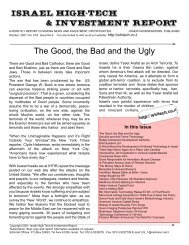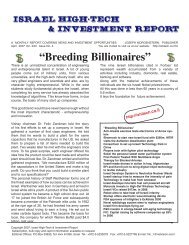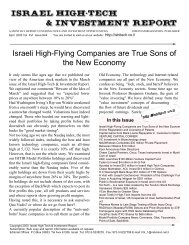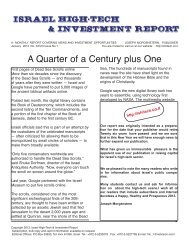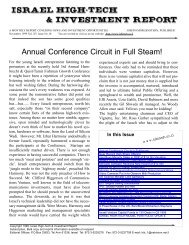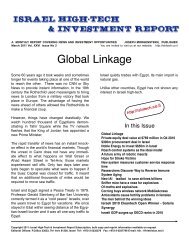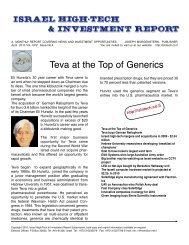Why is there only One Teva? - The Israel High Tech & Investment ...
Why is there only One Teva? - The Israel High Tech & Investment ...
Why is there only One Teva? - The Israel High Tech & Investment ...
You also want an ePaper? Increase the reach of your titles
YUMPU automatically turns print PDFs into web optimized ePapers that Google loves.
November 2004<br />
as "bodily pacemakers" when injected directly into<br />
failing animal hearts. <strong>The</strong> researchers at the<br />
<strong>Tech</strong>nion-<strong>Israel</strong>i Institute of <strong>Tech</strong>nology in Haifa<br />
reported that the versatile cells were able to correct<br />
faulty heart rhythms in pigs when used th<strong>is</strong> way.<br />
Ultimately scient<strong>is</strong>ts hope th<strong>is</strong> technology could<br />
replace the electronic pacemakers currently used to<br />
treat humans with irregular heartbeats, .<br />
<strong>The</strong> <strong>Israel</strong>i team from <strong>Tech</strong>nion-<strong>Israel</strong> Institute of<br />
<strong>Tech</strong>nology, along with US colleagues, took the stem<br />
cells from donated human embryos.<br />
<strong>The</strong> process <strong>is</strong> described in the journal Nature<br />
Biotechnology.<br />
In healthy hearts, groups of special heart cells make<br />
the organ beat regularly by stimulating the heart<br />
muscle cells to contract.<br />
In people where th<strong>is</strong> mechan<strong>is</strong>m fails, an electronic,<br />
battery-powered pacemaker <strong>is</strong> implanted to keep the<br />
heartbeat going.<br />
<strong>The</strong>se devices may need replacing and some<br />
electrical equipment, such as certain mobile phones,<br />
can interfere with the way they work.<br />
In compar<strong>is</strong>on, "natural" pacemakers made from the<br />
body's own cells would need no power source and<br />
would become part of the heart.<br />
Dr Lior Gepstein and h<strong>is</strong> team took embryonic stem<br />
cells and used chemicals to coax them to grow into<br />
standard heart muscle cells.<br />
Some of these cells were seen to beat spontaneously<br />
in the same way as healthy heart muscle.<br />
<strong>The</strong> scient<strong>is</strong>ts <strong>is</strong>olated these cells and injected them<br />
into the hearts of pigs with abnormally slow heart<br />
rates. In 11 out of 13 pigs, the injected cells produced<br />
their own heart rhythm. In five of the pigs, th<strong>is</strong> was<br />
limited to short bouts, but in six of the pigs the beat<br />
was sustained and resembled the pattern of a normal<br />
beating heart.<br />
<strong>The</strong> researchers said their research provided<br />
evidence that the same technique could potentially<br />
be used to make a "biological pacemaker" to treat<br />
human patients with heart conditions.<br />
"Our proof-of-concept study suggests the use of<br />
excitable cell grafts as a biological alternative to<br />
implantable devices," they said.<br />
But they added: "Nevertheless, several obstacles<br />
must be overcome before th<strong>is</strong> strategy can reach the<br />
clinic."<br />
<strong>The</strong>re <strong>is</strong> a theoretical r<strong>is</strong>k that the cells could become<br />
cancerous or that the body would reject the cells.<br />
But, on the positive side, the embryonic stem cells<br />
have the advantage over other cell candidates for<br />
repairing hearts of being able to be made in unlimited<br />
numbers, the scient<strong>is</strong>ts said.<br />
Dr Tim Bowker, Associate Medical Director of the<br />
Brit<strong>is</strong>h Heart Foundation, said: "Th<strong>is</strong> study provides<br />
interesting findings about human heart cells grown<br />
from stem cells, and used in laboratory experiments<br />
on animal heart t<strong>is</strong>sues.<br />
"<strong>The</strong> BHF supports stem cell research, but the use of<br />
the techniques described <strong>is</strong> a long way from clinical<br />
application in humans.<br />
"Use of stem cells in the treatment of heart d<strong>is</strong>ease<br />
has been proposed for a range of heart conditions,<br />
and th<strong>is</strong> research adds to th<strong>is</strong> l<strong>is</strong>t of potential future<br />
applications for stem cells in treating Britain's biggest<br />
killer."<br />
<strong>Israel</strong><strong>is</strong>' Overseas <strong>Investment</strong> Jumped<br />
to $737m<br />
Overseas investment by <strong>Israel</strong><strong>is</strong> has r<strong>is</strong>en sharply.<br />
Overseas investment by <strong>Israel</strong><strong>is</strong> totalled $737 million<br />
in August, including $116 million in financial<br />
investment in negotiable securities, show Bank of<br />
<strong>Israel</strong> figures.<br />
Foreign direct investment in companies and incomeproducing<br />
real estate by <strong>Israel</strong><strong>is</strong> totalled $550 million.<br />
Th<strong>is</strong> figure includes strategic investment in<br />
apartments and land by <strong>Israel</strong>i companies active<br />
overseas.<br />
Foreign investment in negotiable securities totalled<br />
$339 million in August. Direct foreign investment in<br />
<strong>Israel</strong>, including in companies and real estate, totalled<br />
an additional $163 million.<br />
Foreign investment in <strong>Israel</strong> totalled $4.1 billion in<br />
January-August 2004, 74% of the $5.5 billion in<br />
foreign investment in 2003 as a whole.<br />
Foreign direct investment in <strong>Israel</strong>, including<br />
companies and real estate, totalled $1.52 billion in<br />
January-August, 40% of the total foreign direct<br />
investment in 2003 as a whole.<br />
Foreign financial investment in <strong>Israel</strong> totalled $3.26<br />
billion in January-August, 33% more than in 2003 as a<br />
whole. Foreign investment in the Tel Aviv Stock<br />
Exchange (TASE) fell by $491 million, compared with an<br />
increase of $372 million in 2003 and $46 million in 2002.<br />
9



